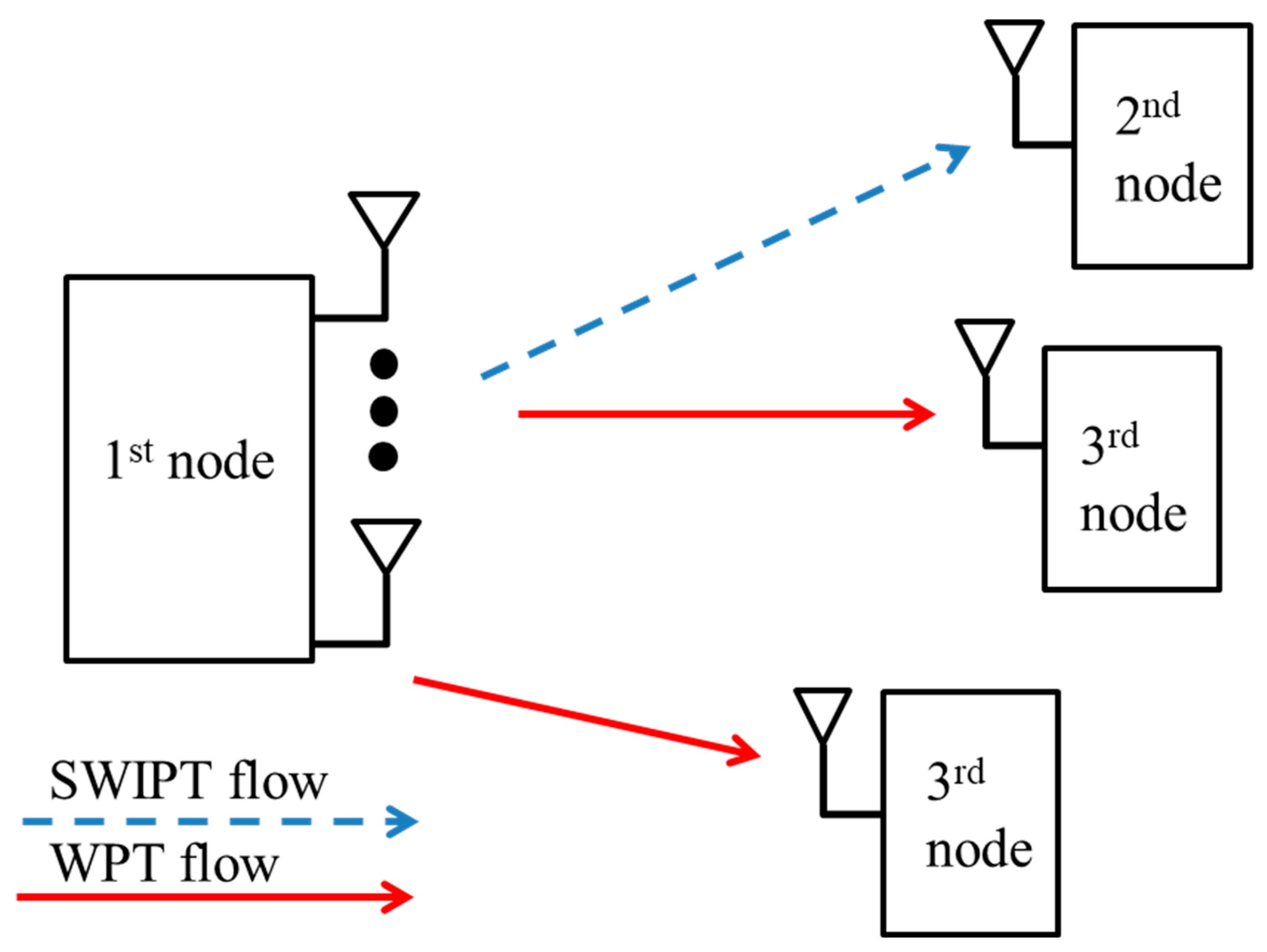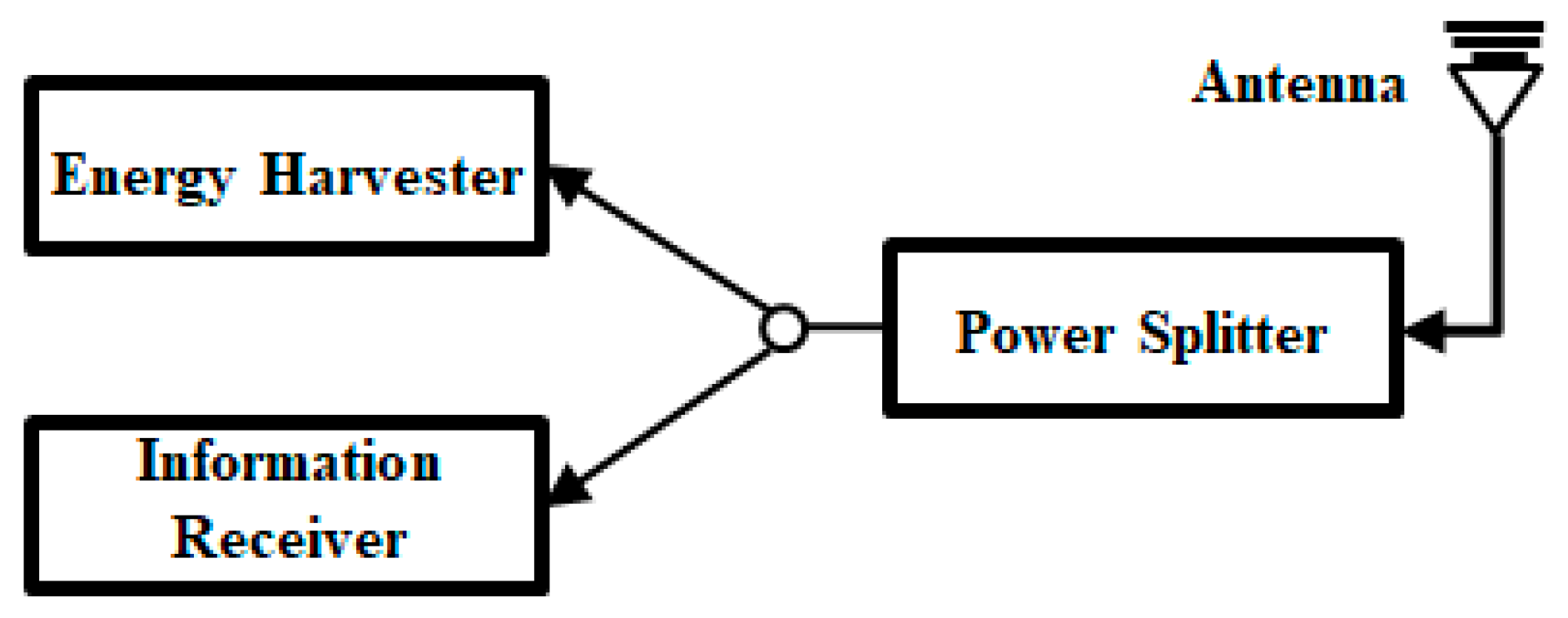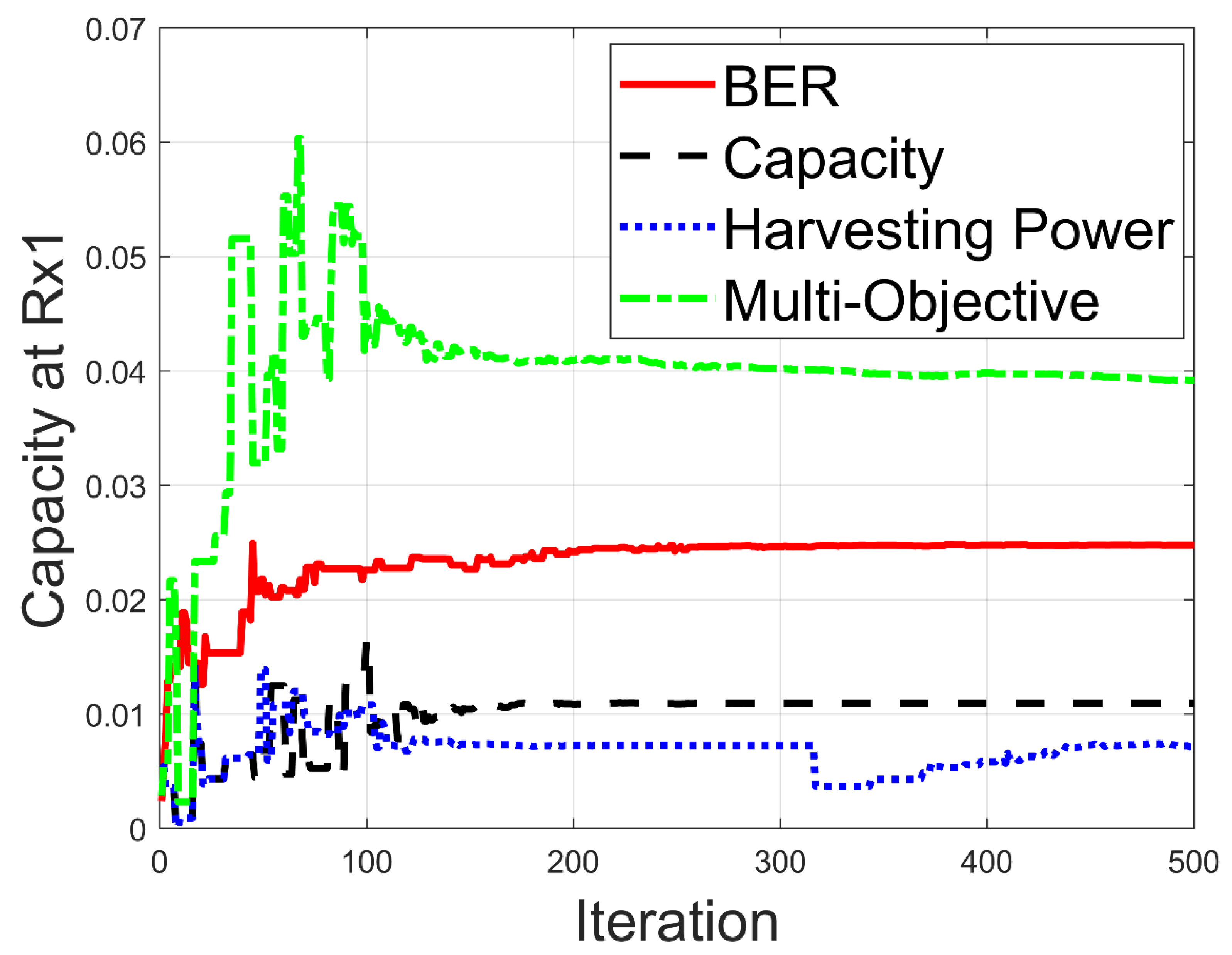1. Introduction
We can recognize two practical architectures of wireless power transfer (WPT) in communication systems: wireless powered communication networks (WPCNs) [
1,
2,
3,
4,
5,
6,
7] and simultaneous wireless information and power transfer (SWIPT) [
8,
9,
10,
11,
12,
13,
14,
15,
16]. The first one describes the situation where a downlink signal shares power and the uplink signal is utilized to transfer information. On the contrary, the other one describes a situation where both information and power can be acquired from the downlink signal. When the enormous wireless nodes are deployed ubiquitously, WPT can be a convenient option for wireless nodes. However, some nodes not only need to be powered by a wireless system but also have information requests. The method for accomplishing this is known as SWIPT. The SWIPT method allows tools to gather power and transfer data simultaneously.
In recent years, potential SWIPT applications have been investigated with the rapid development of mobile communication systems and the Internet of Things (IoT). The millimeter-wave SWIPT application is regarded as one of the best potential candidates for use in the future. There has been a wide array of millimeter-wave communications that can be used to support a wide bandwidth for applications with high data transmission and massive power accesses. Despite the potential of millimeter-wave application, there are many accompanying challenges that need to be investigated and solved. The high frequency will cause the path-loss and the shadowing effect in real environments. In particular, beamforming techniques using antenna arrays are suggested in order to conquer substantial depletion at a high regularity [
17].
The work by Kamga and Aïssa [
7] researched the efficiency of mmWave substantial multiple-input multiple-output WPCNs with and without rain depletion. A dynamic energy splitting receiver was recommended to split the obtained signal with flexible power proportion for power harvesting and also information decoding [
8]. Zhang and Ho [
9] examined a multiple-input multiple-output (MIMO) SWIPT system. Beamforming techniques were used for transmitting to the power and information receiver. In a study by Ng et al. [
12], multi object source allocation for protected interaction in cognitive radio networks was researched. Sources and tasks scheduling for the SWIPT IoT systems while focusing on reducing the power usage needed to guarantee the minimal ordinary information rate and task performance rate were presented by Lee and Lee [
13]. However, most papers deal with the optimal analytic solution with the signal to noise ratio (SNR) constraint for narrow band signal transmission. For wide band signal transmission, the bit error rate performance should be considered in the wireless wideband communication system due to the frequency selective effect of the multipath channel and inter-symbol interference (ISI) instead of SNR only. In this paper, a wideband circular array is used to manufacture the array pattern in order to optimize the bit error rate (BER), capacity, and the energy harvesting efficiency by evolution algorithms. To the best of our knowledge, the multiple objective function for this problem by self-adaptive dynamic differential evolution (SADDE) has not been previously reported in the literature.
The system model and academic formula are presented in
Section 2,
Section 3 explains the evolution algorithm. In
Section 4, numerical results for four different criterion cases with evolution algorithm are presented and compared with the system quality and the harvesting power. Conclusions are presented in
Section 5.
2. System Model
An indoor millimeter wave system with WPT and SWIPT is considered for short distance. We utilize the ray-tracing method to compute the environment channel and the channel regularity feedback can be acquired as follows:
where the frequency of sinusoidal wave is
and the path index is
. Both
and
are the i-th phase shifts with receiving magnitudes for different frequencies. The total number of the receiving ray is
. The regularity feedback can transform to the time domain by utilizing the inverted fast Fourier transform. We can compose the time domain impulse feedback of the equivalent baseband here as follows:
where we have the overall number of paths observed at time Q.
and
are the channel gain and time delay for the q-th path, respectively.
Regarding the system nodes, there are three type nodes in our system, which is shown in
Figure 1. First, there are the transmitter nodes. There are N antennas in the antenna array to protect against the path loss in the millimeter wave and to focus the transmission power efficiently. Second is the SWIPT node; this node uses one antenna to receive the signal information and harvest power. The third type of node is only used for harvesting power in downlink transmission.
We made use of the power-splitting style in SWIPT node, as displayed in
Figure 2. The received radio frequency (RF) signals are divided into two streams for the information receiver and RF power harvester with various power levels.
A circular array with N millimeter wave dipole antennas is shown for the first type of node in
Figure 3.
The array factor for the antenna array is as follows:
where the
and
is the spherical coordinate system,
N is the total number of antennas in the circular array, and
is the distance from the antenna position to coordinate center.
includes the excitation current
and phase delay
.
is the wavenumber and
is the wavelength.
can expressed as follows:
where
is the relative permittivity of the feed line,
is the feed length of line needed to adjust the phase delay, and
c is the speed of light.
In the second type of node, the power-splitting architecture in the system is used, as shown in
Figure 2. The obtained RF signals are divided into two streams for the information receiver and RF power collector with various power levels. Let
signify the energy-dividing coefficient for the receiver (i.e.,
is the portion of RF signals utilized for power gathering). The total energy collected from the receiver is modeled as:
In a SWIPT system, the quality of information is also important. Thus, we consider the BER and capacity as the information quality for the millimeter wave system. The BER considers the inter-symbol-interference in our case and is as follows [
18]:
where
is the complementary error function and
is the binary sequence.
The average channel capacity is as follows:
where
C is the average channel capacity and
B is the bandwidth of the system.
is the bandwidth for each different frequency channel. The signal to noise ratio at the receiver is
. is the total number of frequencies for the system. The third type of node is used to harvest RF energy with full power in downlink transmission.
4. Numerical Result
In this paper, a millimeter wave system from 59 GHz to 60 GHz is proposed, and the corresponding channel is calculated by ray tracing technology. The setting of the actual office environment is shown in
Figure 5, and (Length, Width, Height) is used to describe the size of the furniture. There are three receivers (Rx1, Rx2, Rx3) and one transmitter (Tx) in the office. We used short dipole antennas in this case. If the feed length of the transmitting antenna array is set to the same value, the harvesting powers at Rx1, Rx2, and Rx3 are
,
and
, respectively. In our case,
is set to 1 and the SADDE algorithm is utilized to adjust the feed length for
. We set the radius of the transmitting spherical antenna array a to 0.006 m, while the separation distance between antennas is about
for decreasing the coupling in each antenna. The total number of the transmitting antennas is 16 for the beamforming technique. The
is set to 40 dB. Here, the
is the transmission power to the noise ratio. The Rx1 is used to transfer the information and harvest power with the power-dividing architecture. We set
to 37 dB at Rx1 for information decoding because the Rx1 uses 50% power-splitting for information decoding. Likewise, the
for harvested power at Rx1 is also 37 dB because the 50% power-splitting is 3 dB. Rx2 and Rx3 are used to harvest power with the
(The transmission power to the noise ratio)40 dB. In our study, there are four different objective functions, as shown in
Table 1. Note that we use SADDE to find the minimum value of the objective features. The population size is set to 30 and the iteration is set to 500.
,
, and
are the weighting to adjust the capacity, BER, and harvest power (HP), respectively, for the multiple objective function. The weighting is set according to the optimization of Rx1 by SADDE with the corresponding single objective function. In other words, we use the algorithm to search the optimization for Rx1 with
,
, and
, respectively. According to the numerical result, we can get the weighting of the multiple objective function. Thus, we set the weighting as
,
, and
for the multiple objective function. Note that the weighting considers the maximum value of optimization function for balancing multiple objectives.
Figure 6 shows the BER at Rx1 for different object functions. In
Figure 6, we can see that the BERs for the multiple objective function and BER objective function are very low, at
and
at Rx1, respectively, Note that the total BER sum of all receivers (Rx1, Rx2, and Rx3) are
and
for the multipath objective function and BER objective function, respectively. Thus, if we compare the BER at all receivers in this case, the BER objective function is much smaller than the multiple objective function, since the BER objective function optimizes all receivers, but the multiple objective function did not consider the BER at Rx2 and Rx3.
Figure 7 shows the values of capacity at Rx1 for different object functions. The capacity at Rx1 for the multiple objective function is higher than that for the capacity objective function. The capacity sums of all receivers are 0.2242 and 0.2102 for the capacity objective function and the multiple objective function, respectively. It is found that the capacity sums of all receivers are the largest for the capacity objective function. Note that the objective function not only considers Rx1’s performance but also optimizes the other objectives. As a result, the optimization of Rx1 will not always approach to the extremum, since the objective function optimizes all objectives. The Rx1’s capacity for harvesting power objective is the smallest, since the Rx1 uses the power-splitting architecture for SWIPT. As a result, the optimization focuses on optimizing Rx2 and Rx3, since the contribution of total harvesting power is large for Rx2 and Rx3 compared to Rx1.
Figure 8 depicts the harvesting power for different objective functions. In
Figure 8, it can be seen that the total harvesting power for the HP objective function, the capacity object function, and the multiple objective function are larger than the BER objective functions. The total harvesting power ratio for the HP objective function and the capacity objective function are 101 and 104, respectively. The best harvesting power ratio is 112 for the multiple objective function. Although the harvesting power of the HP objective function and the capacity objective function are close to the multiple objective function, the BER at Rx1 is worse than for the multiple objective function. This means that the multiple objective function can consider all of the criteria at the same time.
Figure 9 shows the harvesting power at Rx1, Rx2, and Rx3 for the HP objective function. From
Figure 9, it is clear that the harvesting power at Rx2 and Rx3 is larger than Rx1. The harvesting powers at Rx1, Rx2, and Rx3 are plotted in
Figure 10 for the multiple objective function. The multiple objective function not only focuses on Rx2 and Rx3, but also considers the quality at Rx1. Compared to
Figure 9, it is clear that the harvesting power for Rx1 increased a lot for the multiple objective function. Thus, the multiple objective function can adjust the total goal better than the single objective function and achieve the overall best solution.
Figure 11,
Figure 12,
Figure 13 and
Figure 14 show the radiation patterns for four different objective functions. In comparing
Figure 11 and
Figure 5, the latter of which shows the location of the transmitter and the receivers, the beams for the multiple objective function and BER objective function have all directed to Rx1, Rx2, and Rx3 with almost equal gain. However, for the BER objective function in
Figure 12, it can be seen that the pattern for Rx1 is the largest compared to those for Rx2 and Rx3. Because of the power splitting at Rx1, the algorithm gives more power to lower the BER at Rx1 by high antenna gain. As a result, the total BERs of Rx1, Rx2, and Rx3 can be reduced. Note that BER is not only affected by the SNR but is also affected by the multi-path with ISI. Since the BER objective function needs to minimize the sum of BER at Rx1, Rx2, and Rx3, the pattern is not similar to that of the multiple objective function. The radiation patterns for the capacity objective function and HP objective function are plotted in
Figure 13 and
Figure 14, respectively. In
Figure 13 and
Figure 14, we can see the beam focus on Rx2 and Rx3. It is consistent with the result in
Figure 7 in that the capacities at Rx1 are small for the capacity objective function and HP objective function. According to these results, the single objective function can only successfully optimize BER, capacity, or power harvesting. However, the multiple objective function can balance the data quality and power harvesting when the suitable weighting is applied.
5. Conclusions
To optimize the harvesting power and information quality for WPT and SWIPT system at millimeter wave in a real environment, we compared different objective functions in this paper, and we used SADDE to optimize and compare the types of objective functions.
For the SWIPT system, we considered BER, capacity, and HP for harvesting power and information quality. The capacity objective function and the HP objective function were able to optimize all of the WPT type node receivers, but the information quality and the harvesting power demonstrated poor performance on the SWIPT type node. Although the information quality was able to optimize the best performance at SWIPT type node for the multiple objective function, the power harvesting was less than that for the HP objective function. The power splitting of Rx1 let the algorithm focus on the optimization of WPT type node for the HP objective function, since the HP objective function only considers the total receiving power from the transmitter instead of the information quality at the SWIPT type node. For these reasons, we used the multiple objective function to optimize the SWIPT node. Note that the BER was not only affected by SNR but also the inter-symbol-interference from multi-path. As a result, the multiple objective function shifted some harvesting power to improve the information quality at the SWIPT type node. Upon viewing the numerical results, we can see that the multiple objective function can balance the SWIPT type node and WPT type node. Thus, in the case of considering many criteria, we can use the multiple objective function to optimize our problem by suitable weighting.




















